Welcome, Commander players! This primer covers the basics of playing Dimir in Commander, part of a ten-part series that covers all of Magic’s two-color pairs. In this series, we go through the strengths and weaknesses of each color pair, as well as common play styles. You can read our other primers so far: Azorius, Simic, Selesnya, Rakdos, Boros, Izzet, and Golgari.
House Dimir is a guild shrouded in secrecy, which often manifests in its playstyle. Players will tread lightly, reacting to game changes at instant speed. Blue-black lends itself to classic hard control, with the goal of having more answers than your opponent’s threats. Staying ahead of everyone else can be difficult in Commander, however, so Dimir has to play different archetypes. The guild leans heavily in the mill direction, or to decks that want as big a graveyard as possible. This graveyard-centric style has its pluses and minuses, and we’ll explore them today.
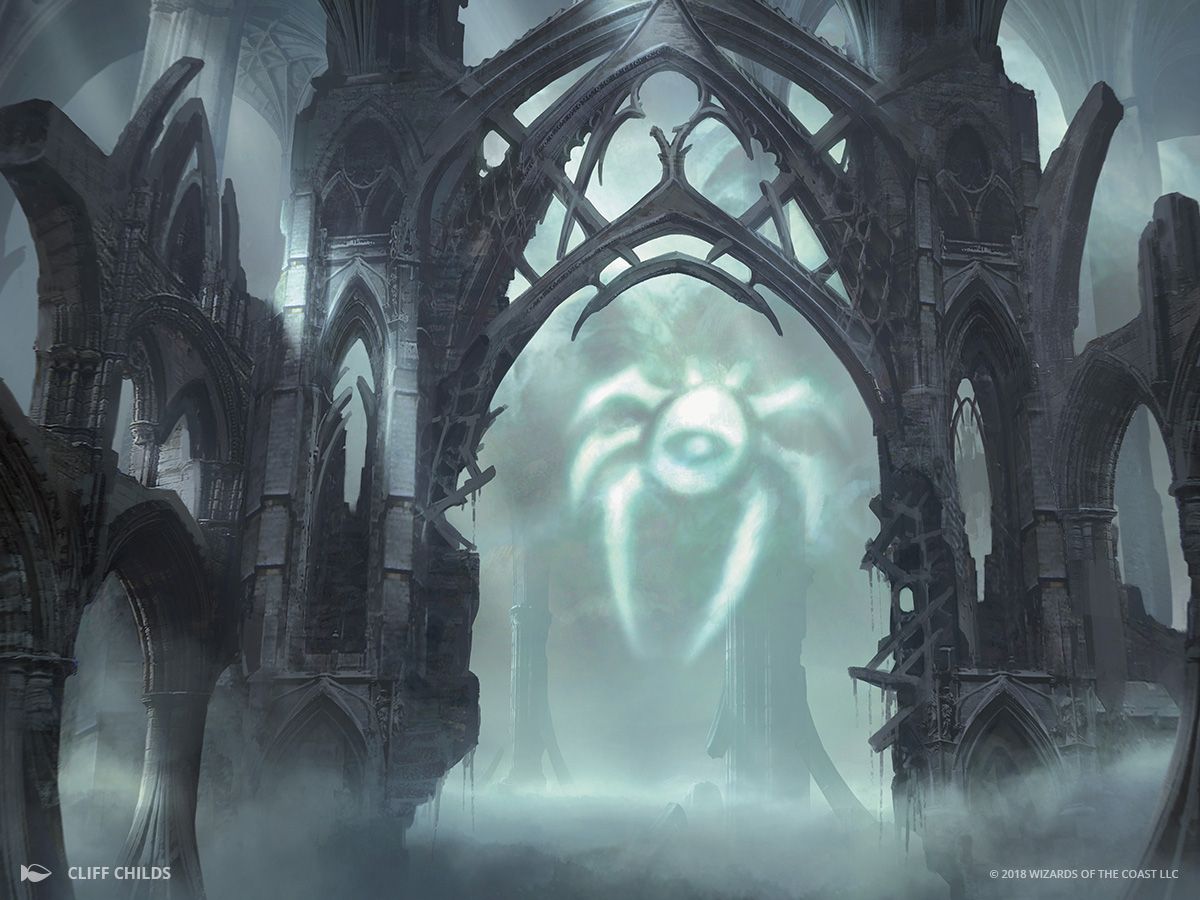
Dimir Guildgate by Cliff Childs.
Strengths
Card draw/selection: Dimir is easily one of the best color pairs for drawing cards. Black wants you to pay life for resources, so you’re looking at cards like Greed, Ambition’s Cost, and even Necropotence. Since Commander games start at 40 life, the life loss is negligible. On the other hand, blue offers unfettered draw power. It can play Treasure Cruise, Mystic Remora, and Blue Sun’s Zenith, just to name a few. For Dimir players, there are more good card draw spells than there are slots to fit them.
After the monocolor staples, the multicolor options are somewhat sparse. Notion Rain and Whispering Madness fit into specific strategies, but they’re not a universal fit. However, if you’re seeing decks like Tatyova, Benthic Druid in your playgroup, make sure to pack Sire of Stagnation. Commander is a format of fetch lands, so you’re bound to get a lot of value there.
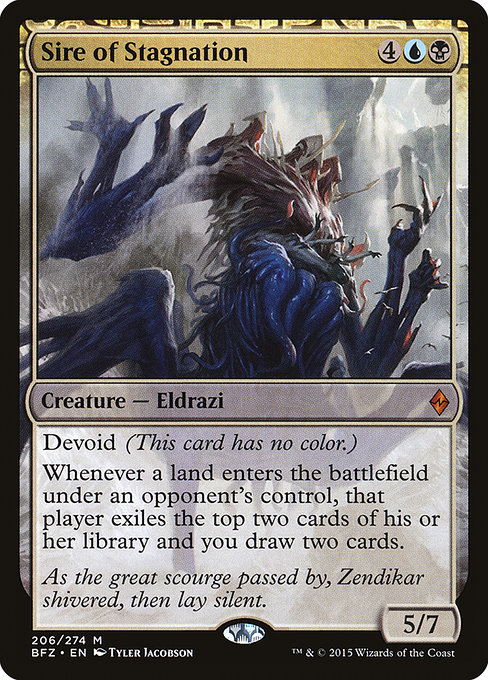
Since these decks usually work with the graveyard, blue has plenty of ways to fill the bin. Frantic Search, Thirst for Knowledge, and Thirst for Meaning are three such examples. Black can do this as well, with cards like Stitcher’s Supplier and Ransack the Lab. By seeing more cards than their opponents, Dimir players can dig deeper and faster to the answers they need. In decks like Lazav, the Multifarious, those cards in the graveyard are still very much an asset.
Single Target Removal: If you want something gone, then Dimir is a good color pair to play. Whether it’s for a threat on board, or on the stack, there are plenty of options to choose from. Blue can counter spells on the stack and bounce or exile cards off the board; black specializes in the destruction of creatures (and planeswalkers).
Dimir has no trouble getting rid of creatures. Black has staples like Doom Blade, Hero’s Downfall, and Tragic Slip. Blue offers some exile-based removal with replacement effects like Pongify, Reality Shift, and Curse of the Swine. And blue brings the countermagic staples like Counterspell and Negate. On top of those classics, Dimir players have some fun multicolor options, like Drown in the Loch, Undermine, and Countersquall. Perplex can be cast early or transmuted away later. Meanwhile, you have your modal spells like Dimir Charm, Soul Manipulation, and Silumgar’s Command.
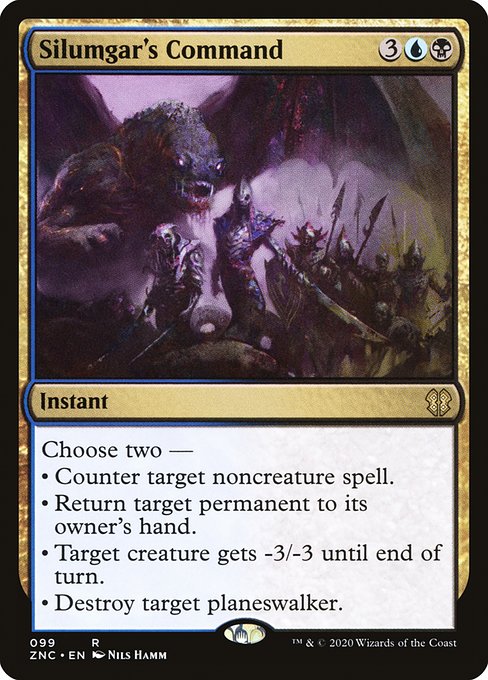
Both colors struggle to remove artifacts and enchantments. While you could play a card like Scour from Existence, the lion’s share of responsibility falls on blue. Unless the Dimir player can counter them early on, they’re left bargaining with other players to remove them. Bounce effects are playable too, but have varied levels of success. A player has to be pretty desperate to cast Cyclonic Rift to bounce a nonland permanent, instead of waiting to overload it later. A bounce is usually at its best when it’s paired with another effect, like Recoil, Dinrova Horror, or Cryptic Command.
Board Wipes:To sweep the board, Dimir looks at monocolor heavyweights like Cyclonic Rift, Toxic Deluge, and Damnation, along with cards like Soulquake.
While Dimir can’t destroy artifacts and enchantments wholesale, they have a variety of mass bounce effects. For the truly devious, cards like Rebuild or Evacuation can be cast in response to Windfall. While these cards don’t permanently get rid of those threats, it may buy enough time to go for the win. Even if the game goes long, you’re making your opponents reinvest their mana and time. Those setbacks can be as crippling as sending those cards to the graveyard. When they hit players with lots of permanents, sometimes they’re forced to discard a large portion at the end of their turn. Also, tokens made off of Smothering Tithe or Dockside Extortionist get swallowed up by a card like Reduce to Dreams.
Graveyard Recursion: Dimir works well with the graveyard. Black focuses on getting creatures back, whereas blue interacts with instants, sorceries, and artifacts. Different styles of Dimir decks have particular enablers best suited to that deck. For instance, Gisa and Geralf Zombie decks can play Patriarch’s Bidding. Sygg, River Cutthroat might use Snapcaster Mage to recast Undermine. These effects can be either for short-term value, or for game-winning effects.
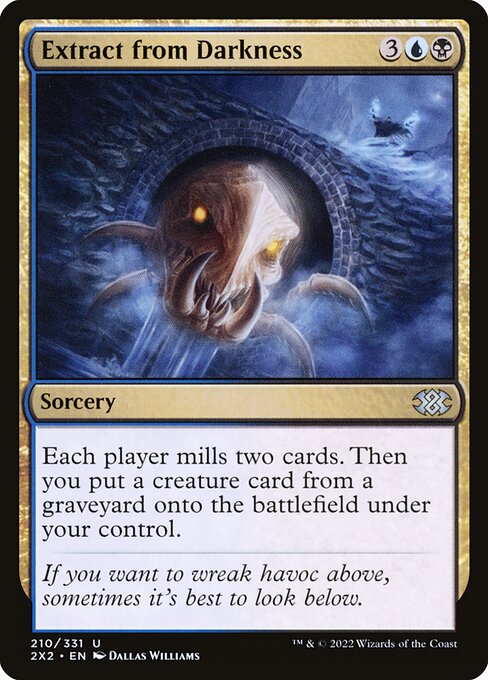
When combining the two colors, Dimir has a unique way of interacting with creatures in the graveyard. These revolve around either casting or copying a creature, and reaping the benefits. Extract from Darkness, The Scarab God, and Havengul Lich are three fine examples. These also allow a Dimir player to reach outside the confines of blue and black, playing a Reclamation Sage out of an opponent’s graveyard. With how powerful creatures are getting these days, the value these cards bring will only go up.
Theft: If there’s a card that’s causing problems, then why not steal it? Stealing permanents is something Dimir does better than any other color pair. Blue can take control of permanents in play and sometimes even from an opponent’s library. Some of the classic tools here are Treachery, Bribery, and Memnarch. Aethersnatch is a special case, since it can steal a spell right off of the stack. Various creatures that have theft effects built into them, such as Agent of Treachery or Sower of Temptation. If you want to be that player at the table, you can use Ghostly Flicker to target Agent of Treachery and Mystic Sanctuary.
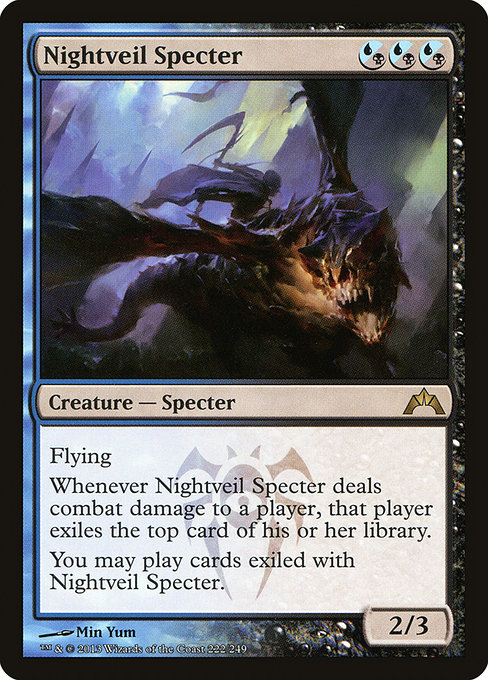
Black has their own tools here. They’re either reanimation spells, or pure theft from the library. Gonti, Lord of Luxury and Praetor’s Grasp steal a card outside of the opponent’s knowledge, which make for interesting game states as your opponents try to guess what you grabbed. You can also simply cast Reanimate or Animate Dead on an opponent’s creature, bringing them in to do your bidding. If you want repeated uses of these effects, you can look at flickering Puppeteer Clique.
Finally, if you want to build a dedicated theft deck in Dimir, then Dragonlord Silumgar is for you. Additional staples of this archetype are Covetous Urge, Hostage Taker, and Thada Adel, Acquisitor.
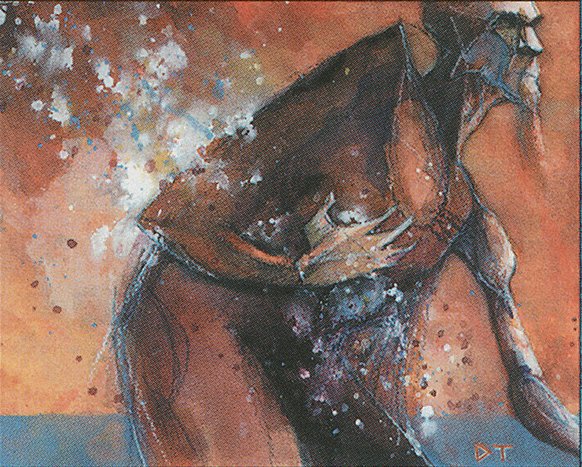
Power Leak by Drew Tucker.
Weaknesses
Format Identity: Dimir is best known in other formats for specializing in slow, reactive Control decks and Turbo Xerox cantrip-aggro decks built around cheap threats like Delver of Secrets and Death’s Shadow. However, these kinds of strategies don’t translate well into multiplayer. Even hard control is lacking, since one-for-one answers don’t go the distance alone. For Commander, the most recognized Dimir archetypes are Mill, Ninjas, and Zombies. Those are the main playstyles for Dimir, followed by Faeries and various flavors of Lazav decks.
Dimir could use more of an identity in the format—one that isn’t so easily swallowed up by Esper, Sultai, or Grixis decks. Kels, Fight Fixer is an exciting new direction for Dimir leaning on sacrifice effects. Aristocrat decks are largely in the other color combinations, but by going into blue and black, this means there’s new space to explore. That’s a much-needed breath of fresh air for Dimir.
Artifacts and Enchantments: Commander decks play a ton of artifacts, and many run problematic enchantments as well. Dimir has big trouble dealing with these types of permanents. You can counter them, bounce them, or steal them. You can also lose to them. As mentioned above, cards like Dinrova Horror can help deal with problem permanents, and you can try to overload Cyclonic Rift or Rebuild in response to someone casting Windfall.
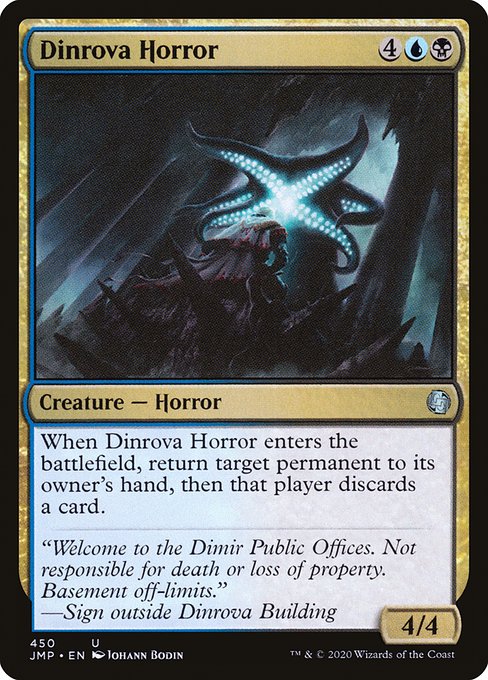
Ramp: When it comes to mana production, Dimir is either boom or bust. Black means that there’s a powerful suite of mana doublers, such as Crypt Ghast or Nirkana Revenant. While these cards can be explosive, not getting them means that the Dimir player is stuck at the back of the pack. Dimir doesn’t have that steady ground game of incremental value, as compared to a Golgari deck. That comes from having three different types of Llanowar Elves, two types of Cultivate, and powerhouses like Nyxbloom Ancient. Without these effects, spread out across multiple cards, a Dimir player can be caught waiting to find their Cabal Coffers.
Weak Creatures: When it comes to strength of creatures, Dimir isn’t high on the list. There aren’t any versions of Craterhoof Behemoth or Aurelia, the Warleader here. To win by attacking, Dimir players have to get creative. They can build around particular creature types, like Zombies, Ninjas, or Faeries. The best option is often the Clone game, copying the powerful creatures played by others. Or there’s Consuming Aberration and Rogue’s Passage.

The irony is that there Magic has no shortage of good blue and black creatures. A lot of the best ones for Dimir are found in other formats, but they don’t have the legs for Commander. After Baleful Strix, the list falls off dramatically. Delver of Secrets, Gurmag Angler, and True-Name Nemesis are three eternal powerhouses that see almost no play. Creatures are more of a tool in the Dimir gameplan than a surefire route to victory.
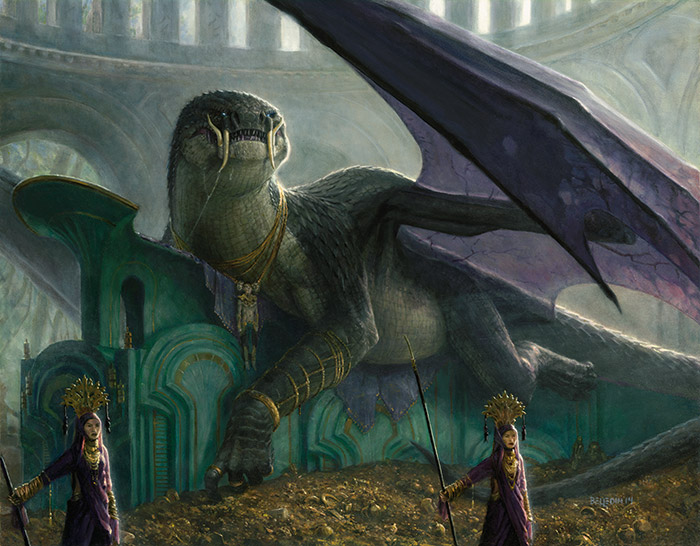
Dragonlord Silumgar by Steven Belledin.
Common Commanders and Archetypes
Mill: Mill is one of the most unorthodox but beloved ways of winning a game of Magic. If you’re unfamiliar, the name comes from the card Millstone and entails causing opponents to put cards from their library into their graveyard until they run out of cards. The archetype attacks opponents on a different axis from life totals, which limits interaction and can lead to an exciting race against time. Phenax, God of Deception, Lazav, Dimir Mastermind, and Mirko Vosk, Mind Drinker are the three main generals, but Dimir has many options when building mill decks. You could also look into Wrexial, the Risen Deep or Szadek, Lord of Secrets.
Self-Mill: This is a slight twist on Mill decks that don’t care about milling the other players, but rather milling yourself for value. Think Lazav, the Multifarious, Gisa and Geralf, and Taigam, Sidisi’s Hand. These decks aim to get as much of their deck into the library, to use it as an extension of their hand. They might be digging for creatures to reanimate with Dread Return, or they could be building towards a winning Thassa’s Oracle play. Either way, these decks always teach the pilot to study and arrange their graveyard neatly.
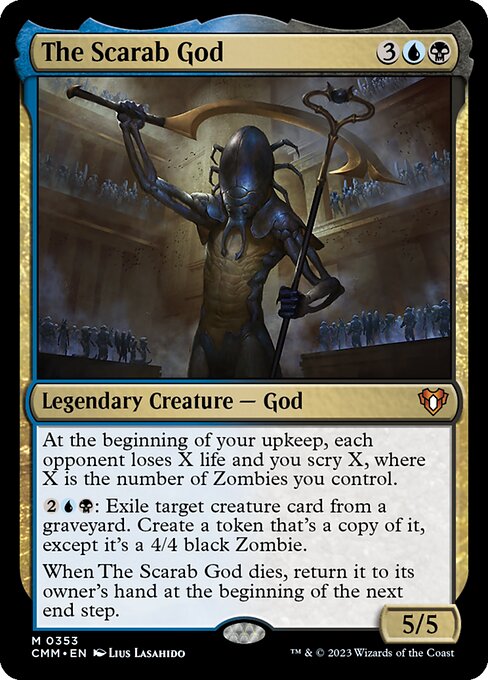
Zombies: While zombie decks can and have been monoblack before, there are plenty of good reasons to go into Dimir. Adding blue allows access to countermagic, board wipes for noncreature permanents, and more card draw. The Scarab God, Gisa and Geralf, and Grimgrin, Corpse-Born are the three contenders here.
Ninjas: Yuriko, the Tiger’s Shadow is the go-to commander—no other legendary creature slots into the ninja strategy as well. This is the deck for bouncing your evasive creatures and reaping the value off of it. If you have a way of giving your creatures evasion, you can keep looping the same two ninjas, over and over again. This combat-based strategy needs some muscle to back it up, so cards like Quietus Spike see play, though make sure that you don’t equip a ninja you plan on returning to your hand. Smoke Shroud offers a sort of way around this problem.
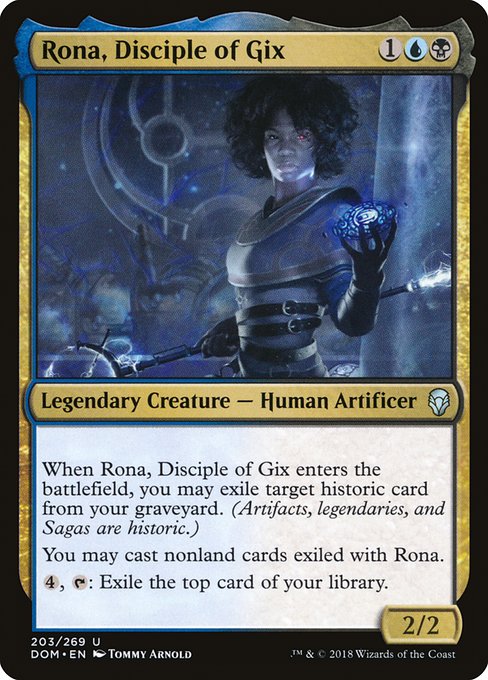
Artifacts: Artifacts have always been associated with blue, but with black in the mix, we get better tutors. Silas Renn, Seeker Adept has built-in recursion, which is great for reusing Tormod’s Crypt or Nihil Spellbomb. Rona, Disciple of Gix is another option for a self-mill artifact theme. She has the backup option of working with things like legendaries and sagas, if you want to focus on a broader scope.
Other Oddities: Kels, Fight Fixer offers a new space for Dimir, and I’m excited to see where players take Dimir aristocrats. Sygg, River Cutthroat is a rogue, merfolk, or control deck that loves to draw cards. Both Lazav decks enjoy copying creatures, whether they’re in your graveyard or your opponent’s. For Lazav, the Multifarious, you can even build a sweet combo deck that wins through infect.
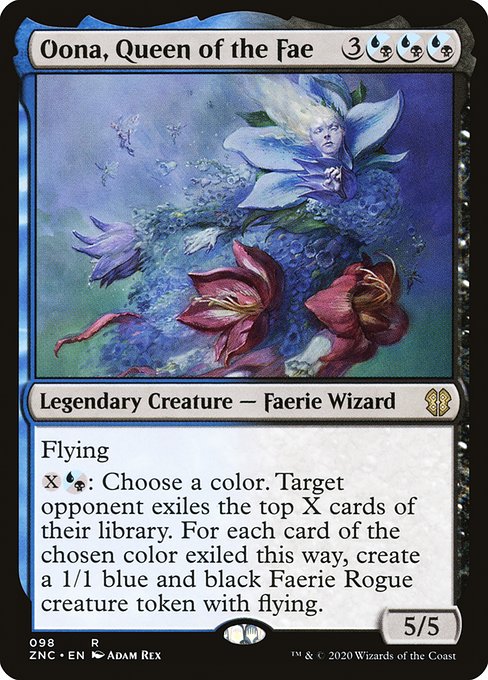
Oona, Queen of the Fae helms the faerie deck, with Mill as a backup plan. Finally, Etrata, the Silencer is a deck that flickers Etrata in response to her combat damage trigger, allowing you to hit players turn after turn. Flicker strategies like this allow for infinite loops, such as Ghostly Flicker targeting Mystic Sanctuary and another permanent.
Final Take
Dimir offers players a variety of powerful answers, and some unique ways to win. For mill strategies, you do everything from emptying your opponent’s libraries to winning off of Thassa’s Oracle. In other areas, you could attack with zombies or ninjas. But sometimes, you just want to cast Torment of Hailfire with three counterspells to back it up. Regardless, there are plenty of ways for Dimir to get you across the finish line.
The color pair could use some more identity in the format, however. Nearly every Dimir legend has something to do with the graveyard, so these decks can be fragile to graveyard hate. It’s a lot of effort to put in, only to be negated by Bojuka Bog. The other Dimir archetypes largely fall on the back of one or two commanders, so options can be limited. We can only wonder how many would-be commanders become Esper, Grixis, or Sultai at the last minute. That’s not an indictment on Dimir per se, but rather it speaks to the way legendary creatures are being designed for Commander.
Travis is a Virginia-based player and writer, who has been turning things sideways since Starter 1999. He primarily plays Commander, Pauper, and Legacy, and has a passion for introducing new players to the game. When he isn’t making people pay the Thalia tax, he can be found mountain biking or playing the guitar. You can follow his exploits here on Twitter and Instagram.

